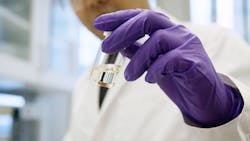Researchers have developed a device that can convert solar heat into electric power. The unique system could provide an alternative to the combination of batteries and solar cells, noted Kasper Moth-Poulsen, professor at the Department of Chemistry and Chemical Engineering at Chalmers University of Technology.
His research team at Chalmers had previously devised a radically new method for capturing solar energy, storing it for up to 18 years, and releasing it on demand. The solar energy system known as Most (Molecular Solar Thermal Energy Storage Systems) was based on a specially designed molecule that changes shape when it comes into contact with sunlight.
That technology has been further developed by equipping it with a thermoelectric generator so it can produce electricity. “It means that we can use solar energy to produce electricity regardless of weather, time of day, season or geographical location,” said Moth-Poulsen, who leads the research. “It is a closed system that can operate without causing carbon dioxide emissions.”
Their paper was published in Cell Reports Physical Science and is a collaboration between researchers in Sweden and Shanghai.
Ultra-thin Chip Converts Heat into Electricity
The specially designed molecule, loaded with solar energy, is paired with an ultra-thin chip or generator, noted to the Swedish researchers, who collaborated with colleagues Tao Li and Zhiyu Hu at Shanghai Jiao Tong University in developing the new device.
Chalmers researcher Zhihang Wang said the chip can be viewed as compatible with ones that can be integrated into headphones, smart watches and telephones. “So far, we have only generated small amounts of electricity, but the new results show that the concept really works. It looks very promising,” said Wang.
What’s Behind the Most Technology?
The closed energy system is based on a specially designed molecule of carbon, hydrogen and nitrogen. The molecule changes shape when hit with sunlight and converts into an energy-rich isomer. It transforms into a molecule made up of the same atoms, but is arranged together in a different way, explained the researchers.
The isomer can then be stored in liquid form for later use when needed, such as at night or in winter. The system has been refined to the point that it is now possible to store the energy for up to 18 years.
The researchers further explained that a specially designed catalyst releases the saved energy as heat. The molecule returns to its original shape, so it can then be reused in the heating system. When the molecule is integrated with the micrometer-thin thermoelectric generator, the energy system can also generate electricity to order, they said.
Clean Energy Source
R&D is still in the early stages, but the innovation has great potential for fossil-free and emission-free energy production, noted the researchers, who envision their technology used for charging electronic devices or heating homes with the system’s stored solar energy.
“Together with the various research groups included in the project, we are now working to streamline the system,” said Moth-Poulsen. “The amount of electricity or heat it can extract needs to be increased. Even if the energy system is based on simple basic materials, it needs to be adapted to be sufficiently cost-effective to produce, and thus possible to launch more broadly.”
View the video: Converting solar energy to electricity on demand




